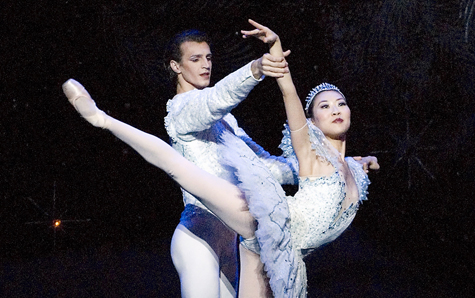
ROMI BEPPU AND SABI VARGA: No problem as Snow Queen and King, but no chemistry, either. |
After a slow start (it was withdrawn after just 11 St. Petersburg performances in the winter of 1892-’93), The Nutcracker went on to become the most-watched ballet of the 20th century, and a staple of the Christmas season. It’s not hard to see why: underneath Tchaikovsky’s sumptuous score and a little girl’s fantasy about defeating the bad guys, saving your favorite toy, and flying off into candyland there’s a tale for adults, anchored in the original 1816 German novella by E.T.A. Hoffmann (Nußknacker und Mausekönig), about a slightly spooky adult (Droßelmeier) who brings his goddaughter a Nutcracker that she loves even though it’s the toy equivalent of the Frog Prince (she sees beauty beneath its ugly surface) and through which she cracks the shell of her childhood. The second-act divertissements aren’t just Clara’s dolls sprung to life, they’re models of grown-up Claras: flirtatious in Chocolate, slinky in Coffee, playful in Tea, tender in Marzipan, blooming in the Waltz of the Flowers — and dancing with a real guy in the pas de deux for the Sugar Plum Fairy and her Cavalier.
In the Boston Ballet Nutcracker that’s up now at the Opera House (through December 29), it helps that the dancer who plays the Nutcracker in the first act becomes Sugar Plum’s Cavalier in the second — Clara rescues him from his enchantment and he and Sugar Plum reward her by showing her what love is. It would make for an even simpler and more powerful story if the ballerina who danced Sugar Plum also played Clara — like Gelsey Kirkland with Mikhail Baryshnikov in the enduring 1978 American Ballet Theatre Nutcracker — and Boston Ballet has the ballerinas to do it: Larissa Ponomarenko, Lorna Feijóo, Erica Cornejo, Romi Beppu, Misa Kuranaga. The company also has a tradition of endearing proper-age Claras; the one I saw Sunday evening was Bronwyn Wada-Gill (she had the role last year too), with a cheeky Xavier Ferreira as her Fritz. The Droßelmeier, Jared Redick, was a little small-scaled — Droßelmeier makes clocks and repairs them, and in Hoffmann’s novella he represents time. Here he has his comic side: he can’t keep his own watch running and at the end of the evening gives it to a delighted Fritz. But he should be larger than life, as when he pops up out of the owl clock as it strikes midnight and Clara’s dream (or is it?) begins. Melissa Hough was a jittery, tightly sprung Columbine with personality, James Whiteside a loose-limbed Harlequin (too loose, really, for a mechanical doll), Mindaugas Bauzys an elegant Nutcracker. I couldn’t fault Sabi Varga and Romi Beppu (replacing Roman Rykine and Larissa Ponomarenko) as the Snow King and Queen, but I couldn’t sense any chemistry, either.

Act two, in the company’s second performance of the day and sixth of the weekend, found the energy level flagging. Melanie Atkins flounced bravely, having little else to do, at her two men in Chocolate; Kelley Potter, with Jaime Diaz, was slinky-withdrawn (think Grace Kelly) in Coffee; Dalay Parrondo and Raul Salamanca set off some Chinese fireworks in Tea. Few explosions from James Whiteside in Russian, however, and Heather Myers was stretched to the limit and beyond as Dew Drop — she uses her upper body well but her legs are weak. And though Erica Cornejo as Sugar Plum brought a dreamy languor to the first section of the pas de deux, she didn’t stretch out her celesta variation, and she was subdued in the finale. And again, no chemistry between her and Bauzys. Was this a Frog Prince of a Nutcracker outing? The audience didn’t think so — or else, like Clara, it saw beauty beneath the surface.